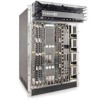Dell Force10 E600i Quick Start Guide - Page 16
Installing a DC PEM, this ensures that each power supply is aligned correctly.
 |
View all Dell Force10 E600i manuals
Add to My Manuals
Save this manual to your list of manuals |
Page 16 highlights
NOTE: Please take precautions against over-tightening the screws or nuts on this device. Installing a DC PEM Step Task 1 Turn the remote power source (the circuit breaker panel) to the OFF position. 2 Turn the over current protector (located on the PEM front panel) to the OFF position. 3 Loosen the PEM safety cover retaining screw and remove the cover. 4 Slide the PEM into power slot 0 or 1. CAUTION: Fill all power supply slots with power supplies or filler blanks before tightening the power supply screws. Doing this ensures that each power supply is aligned correctly. Attempting to tighten screws without all power supply slots filled will cause misalignment with screw holes, which might damage the chassis permanently. If you are only installing one PEM, replace the empty slot with two blank panels. (CCE300-BLNK-PWR.) 5 Tighten the two locking screws on each module with a #2 Phillips screwdriver to secure the PEM in place. As a best practise, insert all screws before tightening each one. 6 Remove the outer nut and washer from each of the remaining studs. 7 Connect the -48 VDC and Return cables from each PEM to the remote power sources. a Verify that the remote power source is in the OFF position. b Locate the appropriate studs on the PEM front panel. The two top studs are the return (+) connection. The cable attached to these studs is typically red. The two bottom studs on the PEM are the -48 VDC () connection. The cable attached to these studs is typically black. Power cables must be terminated only with a UL-listed 2-hole lug to accommodate 1/4-inch studs with 3/4-inch spacing. c Apply a coat of anti-oxidant paste to the connector studs. d Replace the washers and nuts on the studs. e Route the terminated cables out toward the rack rail. f Secure the nuts with a nut driver or torque wrench (not to exceed 4 ft/lbs). 14 Installing the Hardware















